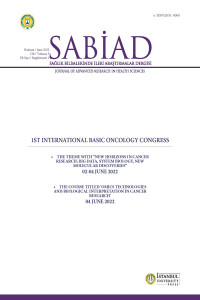S-100 PROTEIN EXPRESSION LEVELS AS A POTENTIAL PROGNOSTIC MARKER IN NEUROBLASTOMA
Abstract
Objective: S-100 is an acidic-calcium-binding protein and was first described in cells of neuroendocrine origin. It plays an important role in various cellular
processes such as cell differentiation and proliferation. S-100 is described to be a negative prognostic marker for the advanced stages of melanoma and
was evaluated to be prognostic biomarker for different cancers. Neuroblastoma(NB) is remarkable for its broad spectrum of clinical behavior, varying from
spontaneous regression to progressive disease and accounts for ~15% of childhood cancer‐related mortality. This diversity in behavior correlates closely
with defined clinical and biologic features and combinations of prognostic variables are used for risk-group assignment. The aim of this study is to
investigate the S-100 expression levels among neuroblastoma patients and to determine if S-100 expression levels could be prognostic biomarker for
neuroblastoma.
Materials and Methods: Histological tumor sections of 40 cases of varying stages and risk groups of neuroblastoma were studied. The patients were staged
according to criteria defined by Turkish Pediatric Oncology Group and International Neuroblastoma Staging System(INSS). Risk groups were determined
according to the International Neuroblastoma Risk Group(INRG) classification system. S-100 protein expression levels were evaluated by immunohistochemical
staining on paraffin sections of neuroblastoma patient tissue samples. All sections were independently and blindly studied for protein expression under
microscopic examination. P values<0.05 was accepted statistically significant.
Results: Schwann cells in the ganglioneuromas and ganglioneuroblastomas always strongly stained. Neuroblastoma cases with early stage and low-tointermediate
risk showed upregulated expression.
Conclusion: While study is still ongoing, preliminary results showed that S-100 could be a candidate prognostic marker for neuroblastoma patients.
Keywords
References
- Arayıcı ME YF, Ellidokuz H. Importance of Cancer Registration and its Place in Cancer Control. Sted. 2021;30(5):366-75
S-100 PROTEIN EXPRESSION LEVELS AS A POTENTIAL PROGNOSTIC MARKER IN NEUROBLASTOMA
Abstract
Objective: S-100 is an acidic-calcium-binding protein and was first described in cells of neuroendocrine origin. It plays an important role in various cellular
processes such as cell differentiation and proliferation. S-100 is described to be a negative prognostic marker for the advanced stages of melanoma and
was evaluated to be prognostic biomarker for different cancers. Neuroblastoma(NB) is remarkable for its broad spectrum of clinical behavior, varying from
spontaneous regression to progressive disease and accounts for ~15% of childhood cancer‐related mortality. This diversity in behavior correlates closely
with defined clinical and biologic features and combinations of prognostic variables are used for risk-group assignment. The aim of this study is to
investigate the S-100 expression levels among neuroblastoma patients and to determine if S-100 expression levels could be prognostic biomarker for
neuroblastoma.
Materials and Methods: Histological tumor sections of 40 cases of varying stages and risk groups of neuroblastoma were studied. The patients were staged
according to criteria defined by Turkish Pediatric Oncology Group and International Neuroblastoma Staging System(INSS). Risk groups were determined
according to the International Neuroblastoma Risk Group(INRG) classification system. S-100 protein expression levels were evaluated by immunohistochemical
staining on paraffin sections of neuroblastoma patient tissue samples. All sections were independently and blindly studied for protein expression under
microscopic examination. P values<0.05 was accepted statistically significant.
Results: Schwann cells in the ganglioneuromas and ganglioneuroblastomas always strongly stained. Neuroblastoma cases with early stage and low-tointermediate
risk showed upregulated expression.
Conclusion: While study is still ongoing, preliminary results showed that S-100 could be a candidate prognostic marker for neuroblastoma patients.
Keywords
References
- Arayıcı ME YF, Ellidokuz H. Importance of Cancer Registration and its Place in Cancer Control. Sted. 2021;30(5):366-75
Details
| Primary Language | English |
|---|---|
| Subjects | Clinical Sciences |
| Journal Section | Meeting Abstract |
| Authors | |
| Publication Date | August 9, 2022 |
| Submission Date | June 29, 2022 |
| Published in Issue | Year 2022 Volume: 5 Issue: S-1 |

